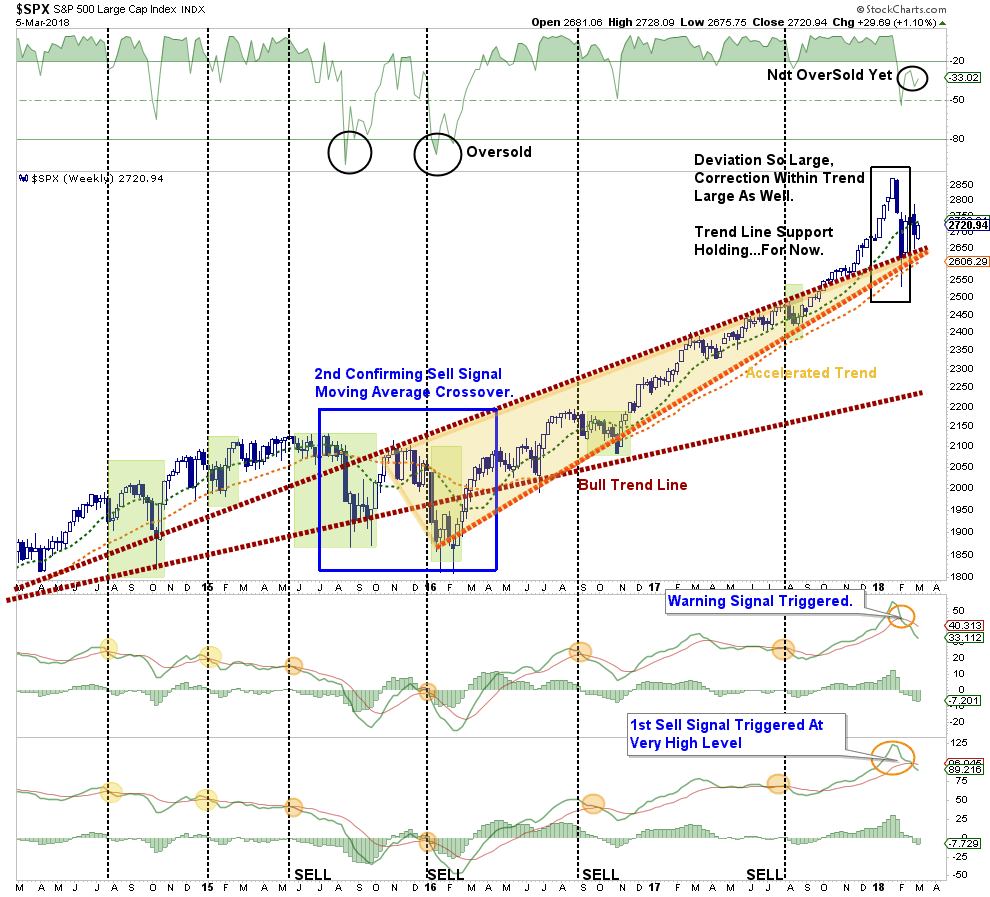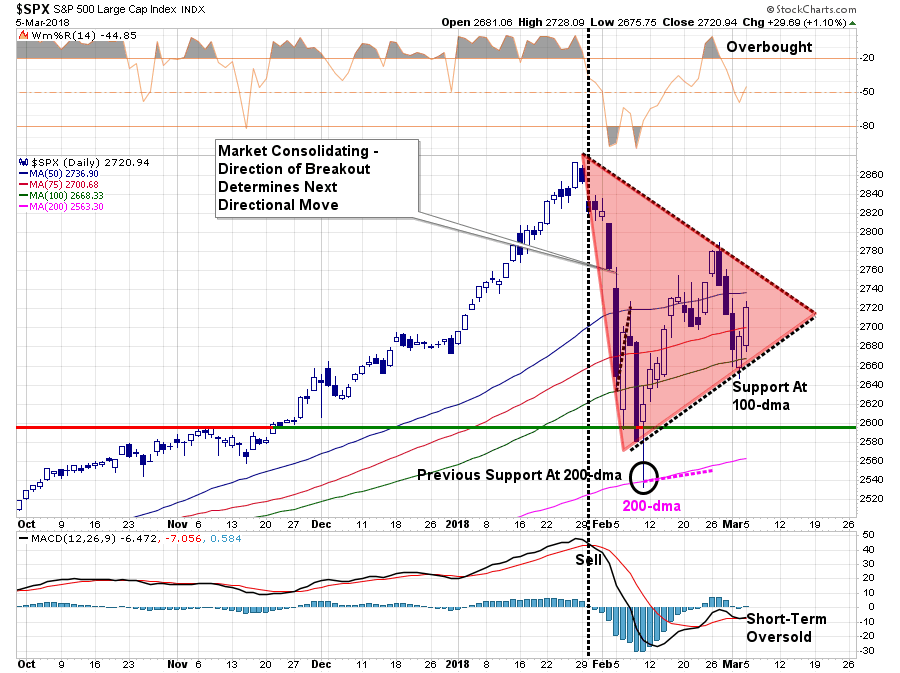Authored by Lance Roberts via RealInvestmentAdvice.com,
This past weekend, I discussed the recent weekly violation of the market back below its respective 50-dma and the triggering of actions in our underlying portfolios.
‘If the market fails to hold the 50-dma by the end of this week, we will add our hedges back to portfolios, rebalance risk in portfolios and raise cash as needed.
We did exactly that on Friday by reinstating our short-market hedge and raised some cash by reducing some of our long-equity exposure. While previously we had only hedged portfolios, the action this past week to simultaneously reduce some equity exposure was due to both of our primary “sell” signals being tripped as shown below.”
Notice that while the much surged more than 1% on Monday:
- Both “sell signals” remain firmly entrenched at relatively high levels
- The market is not oversold as of yet; and,
- Prices remain below the short-term moving average.
All of this suggests the correction process is not yet complete.
On a short-term trading view, the consolidation process continues with the Monday’s rally also remaining below the 50-dma keeping short-hedges in place for now. This is particularly the case given the confirmed “sell” signal on a weekly basis as noted above.
“Most importantly, the market is currently in the process of building a consolidation pattern as shown by the ‘red’ triangle below. Whichever direction the market breaks out from this consolidation will dictate the direction of the next intermediate-term move.”
“Turning points in the market, if this is one, are extremely difficult to navigate. They are also the juncture where the most investing mistakes are made.”
Over the last several weeks, I have been providing constant prodding to clean up portfolios and reduce risks. I also provided guidelines for that process – click here.
The rally on Monday was not surprising, due to the short-term oversold conditions that existed. However, as discussed in the newsletter:
“It isn’t too late to take some actions next week as I suspect we could very likely see a further bounce on Monday or Tuesday.
Use that bounce wisely.”
For now, it is important to note the “bullish trend” remains solidly intact and, therefore, we must give the “benefit of the doubt” to the bulls. However, with “bearish signals” beginning to mount, the increase in risks certainly justifies become more cautious currently. Goldman Sachs recently noted the potential of a further corrective process:
“As has been discussed in previous updates, the market could also be starting a much bigger/more structurally corrective process, counter to a V wave sequence from the ‘09 lows. If that’s the case, there should be room to continue a lot further over time. At least 23.6% of the rally since ‘09 which is down at 2,352.
Bottom line, it’s worth considering the possibility of continuing further than 2,467-2,449. Doing so might imply that this is not an ABC but rather a 1-2-3 of 5 waves down, in a larger degree ABC count that could take months to fully manifest. While it is still far too early to make this call, the important thing to note is that the 2,467-2,449 area will likely be trend-defining.”
Searching For The Greater Fool
ValueWalk recently published the following note:
Klarman writes when purchasing stocks:
“You may find a buyer at a higher price – a greater fool – or you may not, in which case you yourself are the greater fool.”
Here’s an excerpt from Klarman’s book, Margin of Safety, in which he discusses the importance of doing your homework and avoiding speculation when it comes to investing:
“There is the old story about the market craze in sardine trading when the sardines disappeared from their traditional waters in Monterey, California. The commodity traders bid them up and the price of a can of sardines soared. One day a buyer decided to treat himself to an expensive meal and actually opened a can and started eating. He immediately became ill and told the seller the sardines were no good. The seller said, “You don’t understand. These are not eating sardines, they are trading sardines.”‘
Like sardine traders, many financial-market participants are attracted to speculation, never bothering to taste the sardines they are trading. Speculation offers the prospect of instant gratification; why get rich slowly if you can get rich quickly?
Moreover, speculation involves going along with the crowd, not against it. There is comfort in consensus; those in the majority gain confidence from their very number. Today many financial-market participants, knowingly or unknowingly, have become speculators. They may not even realize that they are playing a ‘greater-fool game,’ buying overvalued securities and expecting—hoping—to find someone, a greater fool, to buy from them at a still higher price.
There is great allure to treating stocks as pieces of paper that you trade. Viewing stocks this way requires neither rigorous analysis nor knowledge of the underlying businesses. Moreover, trading in and of itself can be exciting and, as long as the market is rising, lucrative. But essentially it is speculating, not investing.
You may find a buyer at a higher price—a greater fool—or you may not, in which case you yourself are the greater fool.”
via Zero Hedge http://ift.tt/2oPvMTy Tyler Durden


